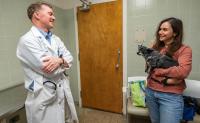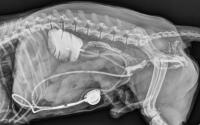
Dedicated Teamwork Successful in Keeping Dog’s Cushing’s Disease Under Control
“Case of the Month” – August 2023
In some ways, Patches is like many other dogs – he loves cuddles, naps, and snacks (his favorite is an apple, but he won’t turn down the occasional strawberry or blueberry). But in one way, Patches stands out from other dogs – he is under continual medical surveillance for a disease that needs constant attention.
“The fact that he bounces back and is still joyful and seemingly strong after all of his procedures makes me feel like I’ve done the right thing,” said owner Jazmin Perez.

Perez regularly drives almost two hours to the UC Davis veterinary hospital for Patches’ appointments. With the complex level of Patches’ conditions over the years, Perez feels more comfortable making the drive and having UC Davis as his primary veterinary medical provider to keep his care consistent.
Why would she go to such lengths for the dog she’s had since he was a puppy?
“He brings a lot of love and purpose to my life,” Perez said. “Patches is a sweet boy with a heart of gold. He has amazing strength and resilience.”
The 10-year-old Chihuahua mix has been a patient of Dr. Sean Hulsebosch for five years since it was first suspected that he had Cushing’s disease. Notoriously difficult to treat, Cushing’s is a result of the adrenal glands producing too much of the stress hormone cortisol. Too much cortisol will weaken a dog’s immune system and can lead to a multitude of disorders. To keep Cushing’s under control, veterinarians must come up with just the right combination and proper dosing of drugs – a fine line that varies with every dog.
Dogs with Cushing’s will show many systemic signs, including increased thirst and urination, increased hunger, thin skin, hair loss, pot-belly appearance, panting, liver changes, among other changes. Patches showed nearly all these symptoms. With intense monitoring, patients with controlled Cushing’s can sometimes go on to live normal lives, so Dr. Hulsebosch, a board-certified internal medicine specialist, was hopeful that a positive outcome could be achieved for Patches.
After several months on Trilostane, a drug that decreases the production of excessive cortisol, Patches’ condition did not improve. Therefore, Dr. Hulsebosch decided to switch to the drug Mitotane, which also suppresses the production of steroids in his adrenal glands via a different mechanism.
“It’s been challenging getting his Cushing’s under control and maintaining the right dosage,” said Perez. “Dr. Hulsebosch has never given up finding the right solution. He’s been there every step of the way.”

By the spring of 2022, Patches’ Cushing’s disease was improved but still poorly controlled. Based on an ultrasound performed at that time, Patches had ureter (tube connecting kidney to bladder) obstructions on both sides causing increased pressure and swelling within his kidneys. This increased pressure caused renal damage and insufficient filtration of toxins from the blood. The resulting kidney infection and subsequent mineralization in the ureters were likely results of his Cushing’s disease.
To clear the ureteral obstructions, surgeons and internal medicine doctors placed stents into each of Patches’ ureters to help open them and improve the flow of urine. The procedure was performed utilizing interventional radiology, a minimally invasive placing of the stents using fluoroscopy to guide the stents into Patches’ urinary system.
While the stents did help to improve Patches’ kidneys and his Cushing’s was under much better control with the other medication, they ultimately didn’t fully solve his ureteral problems, and the obstructions and kidney dysfunction returned by the fall of 2022. A more permanent solution was needed.

UC Davis veterinary surgeons have been achieving success with artificial ureters for the past decade, and the option seemed viable and was a last resort for Patches. Bypassing the natural ureters, surgeons created two new ureters with tubing – one end coming from the kidney, one end leading into the bladder. The two pieces are connected with a titanium shunting port that was placed just under the skin for easy access for collecting urine samples from the system. Known as a subcutaneous ureteral bypass (SUB), the device was placed without complication, and Patches recovered well from surgery.
Now nearly a year since the surgery, the SUBs continue to function well, and Patches’ kidney issues have resolved. Dr. Hulsebosch continues to see Patches regularly to keep the Cushing’s disease under tight control.
“I will forever be grateful to Dr. Hulsebosch for getting and keeping Patches healthy,” Perez said. “I feel his love for Patches.”
“I can’t imagine not having UC Davis available,” Perez continued. “I don’t think that Patches would be around without Dr. Hulsebosch and everybody else on the team. Every single person at UC Davis who has helped Patches has been kind, dedicated, and thorough. You can tell that they care, and that matters to me. I get the sense that they are just as committed to Patches’ health as I am.”
# # #
